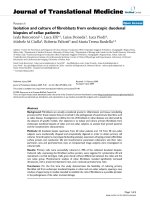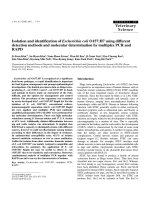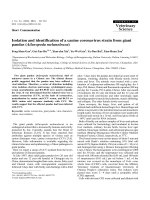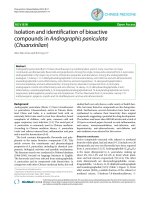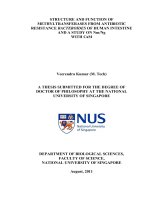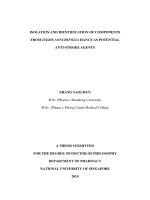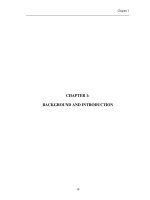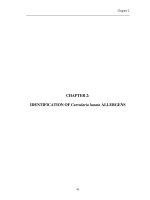Isolation and identification of components from ixeris sonchifolia hance as potential anti stroke agents
Bạn đang xem bản rút gọn của tài liệu. Xem và tải ngay bản đầy đủ của tài liệu tại đây (7.81 MB, 188 trang )
ISOLATION AND IDENTIFICATION OF COMPONENTS
FROM IXERIS SONCHIFOLIA HANCE AS POTENTIAL
ANTI-STROKE AGENTS
ZHANG YAOCHUN
B.Sc. (Pharm.), Shandong University
M.Sc. (Pharm.), Peking Union Medical College
A THESIS SUBMITTED
FOR THE DEGREE OF DOCTOR OF PHILOSOPHY
DEPARTMENT OF PHARMACY
NATIONAL UNIVERSITY OF SINGAPORE
2010
I
Acknowledgement
I would like to express my sincere gratitude to my dear supervisor Dr Chew
Eng-Hui for her continuous encouragement, wise advice and kind support. Her
support, understanding, advice and mentoring have helped guide me through
my doctoral program and my dissertation. Without her, none of this would
have been possible. I know that I will continue to benefit from her advice and
the skills that she has helped me achieve for the rest of my career. Deep
appreciation also goes to my co-supervisor Dr Ng Ka-yun for his great help
throughout the Ph.D project.
Special thanks to Dr Chui Wai Keung for his kind agreement for me to use his
HPLC equipment, and Dr Koh Hwee Ling for her kind agreement for me to
use her Blood Coagulation Analyzer. Their expertise advice on equipment
techniques and analyzing methods accelerated my research progress. A big
thank-you owned to Dr Keith Rogers from Institute of Molecular and Cell
Biology, who helped me process the tissue immunohistological staining.
I would like to thank Dr Chan Lai Wah and Dr Go Mei Lin for their valuable
guidelines on my Ph.D candidature and graduate study. Thanks to the
department lab technicians namely, Ms Ng Sek Eng, Ms Ng Swee Eng, Mdm
Oh Tang Booy, Ms Wong Meiyin, Ms Lye Peypey and Mr Goh Minwei. Their
hard work provided great technical support for my research project. In
addition, I wish to express my deep gratitude to National University of
Singapore for offering the research scholarship that supported my candidature.
A sincere thank to my dear friends in NUS, who never failed to give me great
suggestions in numerous ways. They are Dr Zhou Liang, Dr Lin Haishu, Dr
Ling Hui, Dr Gapter Leslie A, Dr Surajit Das, Dr Yang Hong, Dr Hu Zeping,
Dr Tian Quan, Dr Huang Meng, Dr He Chunnian, Dr Wu Zhenlong, Miss Gan
Feifei, Miss Amrita Abhay Nagle, Miss Shridhivya Reddy Amarr, Miss Jin
Jing, Miss Zhang Caiyu, Miss Yang Shili, Mr Shelar Sandeep Balu, Mr Sun
Feng, Mr Yue Bingde, Mr Wang Zhe, Mr Wang Likun, Mr Tan Jing, Mr Si
Chengtao, Mr Sun Lingyi and Mr Li Jian. The precious time spent with them
will be preserved in my memory forever.
Last but not least, I would like to extend my appreciation to my families. My
respected grandmother, industrious parents and kind sisters, though separated
by an ocean, have never stopped their care. My dear wife, Li Guijun, has
fulfilled my life outside the lab. My lovely daughter, Zhang Xiao, has rendered
me a new angle to observe, feel and understand the world. I’m writing this
thesis to share with all of them.
II
Table of contents
Acknowledgements I
Table of contents II
Abstract VII
List of tables X
List of figures XI
Abbreviations XIV
Chapter 1 Introduction 1
1.1 Stroke 3
1.1.1 Pathophysiology 3
1.1.2 Epidemiology 7
1.1.3 Progress in stroke treatment 10
1.1.3.1 Thrombolysis 10
1.1.3.2 Anticoagulants and antiplatelet drugs 11
1.1.3.3 Neuroprotectants 13
1.1.3.4 Combination therapy 21
1.1.3.5 Traditional Chinese Medicine
23
1.2 Studies on Ixeris sonchifolia Hance 24
1.3 Rationale and aims 28
Chapter 2 Preparation and bioactivity screening of fractions from Ixeris
sonchifolia Hance extract
30
2.1 Introduction 31
2.2 Materials and methods 32
2.2.1 Preparation of Ixeris sonchifolia Hance extract 32
2.2.1.1 Reagents and plant material 32
III
2.2.1.2 Extraction procedures 32
2.2.2 Screening assays to evaluate the bioactivities of Ixeris
sonchifolia Hance extract
32
2.2.2.1 Anticoagulation activity assay 33
2.2.2.2 In vitro MTT cell viability assay 34
2.2.2.3 Evaluation of antioxidant activities of
fractions 1 to 4
36
2.2.2.3a Determination of free radical scavenging
activity
37
2.2.2.3b Determination of inducibility of cellular
antioxidant enzymes and molecules
37
ARE-dependent luciferase reporter assay 37
Western blot analysis of cellular Nrf2 levels 38
GSH measurement 40
2.2.3 Statistical analysis 41
2.3 Results 42
2.3.1 Possible anti-coagulation activities of fractions 1 to 4
isolated from Ixeris sonchifolia Hance extract
42
2.3.2 Effects of fractions 1 to 4 isolated from Ixeris
sonchifolia Hance extract on the viability of H
2
O
2
-exposed
PC12 cells
42
2.3.3 Evaluation of antioxidant activities of fractions 1 to 4
isolated from Ixeris sonchifolia Hance extract
44
2.4 Discussion and conclusions 48
Chapter 3 Isolation and characterization of components from ethyl
acetate fraction of Ixeris sonchifolia Hance
55
3.1 Introduction 56
3.2 Materials and methods 56
3.2.1 Isolation of the fractions from Ixeris Sonchifolia
Hance extract
56
IV
3.2.1.1 Materials and general analytical procedures 56
3.2.1.2 Isolation procedures 57
3.2.1.3 Reactions 58
3.2.2 Quantitative HPLC analysis of compounds 1 to 5 and
7 in fractions 1 to 4 isolated from Ixeris sonchifolia Hance
extract
59
3.1.2.1 HPLC system and mobile phase 59
3.1.2.2 Sample preparations 60
3.1.2.3 Calibration graphs 60
3.1.2.4 Quality control 60
3.3 Results 61
3.3.1 Characterization of purified compounds isolated from
Ixeris sonchifolia Hance
61
3.3.2 Quantitative HPLC analysis of compounds 1 to 5 and
7 in fractions 1 to 4 isolated from Ixeris sonchifolia Hance
72
3.4 Discussion and conclusions 75
Chapter 4 Cytoprotective effects of flavonoid compounds isolated from
ethyl acetate fraction of Ixeris sonchifolia Hance extract
78
4.1 Introduction 79
4.2 Materials and methods 79
4.2.1Preparation of stock solutions of flavonoid
compounds
79
4.2.2 In vitro MTT cell viability assay 80
4.2.3 Determination of LDH leakage
80
4.2.4 Flow cytometric analysis of cell death
80
4.2.5 Determination of free radical scavenging activity
81
4.2.6 ARE-dependent luciferase reporter assay
81
Western blot analysis 82
V
GSH measurement 82
4.2.7 Statistical analysis
82
4.3 Results
82
4.3.1 Effects of flavonoid compounds 1 to 5 on the
viability of H
2
O
2
-exposed SH-SY5Y cells
82
4.3.2 Antioxidant activities of flavonoid compounds 1 to 5
isolated from Ixeris sonchifolia Hance extract
88
4.4 Discussion and conclusions 93
Chapter 5
Anti-inflammatory effects of flavonoid compounds isolated
from the ethyl acetate fraction of Ixeris sonchifolia Hance extract
98
5.1 Introduction 99
5.2 Materials and methods 99
5.2.1Preparation of stock solutions of flavonoid
compounds
99
5.2.2 Cell culture and treatments 100
5.2.3 In vitro MTT cell viability assay 101
5.2.4 Measurement of nitric oxide release 101
5.2.5 RNA extraction and reverse transcription-polymerase
chain reaction
102
5.2.6 Western blot analysis 104
5.2.7 Statistical analysis 105
5.3 Results 105
5.3.1 Effects of flavonoid compounds 1 to 5 on the
viability of RAW 264.7 cells and BV-2 cells
105
5.3.2 Effects of flavonoid compounds 1 to 5 on nitric oxide
production in LPS-activated RAW 264.7 cells.
105
5.3.3 Effects of flavonoid compounds 1 to 5 on LPS-
induced mRNA expression of cytokines in BV-2 cells
107
5.3.4 Effects of flavonoid compounds 1 to 5 on the
expression of Cox-2 and cPLA
2
in LPS-stimulated BV-2
110
VI
cells
5.3.5 Effects of flavonoid compounds 1 to 5 on the
expression of inducible nitric oxide synthase (iNOS) in
LPS-stimulated BV-2 cells
111
5.4 Discussion and conclusions 113
Chapter 6 Possible protective effects of luteolin in rats suffering from
cerebral ischemia induced by middle cerebral artery occlusion
122
6.1 Introduction 123
6.2 Materials and methods 123
6.2.1 Experimental animals 123
6.2.2 Surgical procedures 124
6.2.3 Evaluation of neurobehavior 125
6.2.4 Measurement of infarct area 126
6.2.5 Immunohistological analysis
126
6.2.6 Statistical analysis 127
6.3 Results 127
6.3.1 Effect of luteolin on mortality and neurobehavioral
recovery of MCA-occluded rats
127
6.3.2 Effect of luteolin on infarct area in the brains of rats
suffering from cerebral ischemia induced by MCA
occlusion
128
6.3.3 Immunohistochemistry staining of brain slices
129
6.4 Discussion and conclusions 132
Chapter 7 General discussion and conclusions 137
References 147
VII
Abstract
Ixeris sonchifolia Hance is a small and bitter perennial herb widely
distributed in the northeastern part of China. Its raw extract had recently been
developed into an injectable formulation showing considerable therapeutic
efficacy in stroke management. But the biological targets and the underlying
chemical components remained mostly unknown. Accordingly, (1) the
effectiveness of the herbal preparation may suffer from batch-to-batch
variations since it is difficult to ensure the presence of similar amounts of
active ingredients, and (2) some of the components present in the herbal
formation may pose certain side effects that potentially limit the therapeutic
benefits. This thesis aimed to isolate and identify constituents from Ixeris
sonchifolia Hance that display anti-stroke activities and to elucidate the
possible mechanism(s) through which the identified compound(s) exerted the
neuroprotective effects.
To accomplish this objective, the aerial part of Ixeris sonchifolia
Hance was extracted and the crude extract was partitioned into fractions. The
fractions were then subjected to screening using both cell-based in vitro
bioassays and biochemical reactions. The results had revealed that the ethyl
acetate fraction, although failed to exhibit anticoagulant activities, dose-
dependently protected cells from H
2
O
2
-induced cytotoxicity, scavenged DPPH
free radicals, induced ARE-dependent transcriptional activity and caused
upregulation of Nrf2 protein levels.
The follow-up isolation work focused on the ethyl acetate fraction
revealed the presence of two classes of compounds: flavonoids and
VIII
sesquiterpene lactones. In vitro bioassays conducted on the isolated flavonoids,
which were identified to be Apigenin (1), Luteolin (2), Apigenin-7-O-β-
glucopyranoside (3), Luteolin-7-O-β-glucopyranoside (4), Luteolin-7-O-β-
glucruonopyranoside (5) and Luteolin-7-O-β-galacturonide (6) respectively,
revealed that these compounds could protect cells from H
2
O
2
-induced
cytotoxicity by scavenging free radical directly and inducing phase Ⅱ
enzymes, suggesting that the purified flavonoid compounds might exert
neuroprotective effects during the early response, characterized by excitotoxic
damage and oxidative stress, to stroke occurrence.
Considering that the second wave of cell death after a stroke incident
stems from the neuroinflammatory response, the anti-inflammatory effects of
these isolated flavonoids on the LPS-stimulated cells were next determined.
The results suggested that these flavonoid compounds might exert anti-
inflammatory activities by regulating cytokine secretion, inhibiting Cox-2
expression, as well as reducing NO release and iNOS expression.
As validation, the potential anti-stroke effects of Luteolin, a
representative of these isolated flavonoid compounds, were investigated using
rats suffering from cerebral ischemia induced by MCA occlusion. The results
revealed that while treatment with Luteolin failed to neither reduce MCAO-
induced mortality nor improve neurobehavioral recovery, it significantly
reduced the infarct area, decreased the number of cells positively stained with
anti-cleaved caspase-3 and anti-Cox-2 antibodies, suggesting that Luteolin
might exert neuroprotective effects in an in vivo stroke model.
IX
In conclusion, extraction and isolation works focused on Ixeris
sonchifolia Hance revealed the presence of two categories of compounds in
the ethyl acetate fraction of its raw extract: flavonoids and sesquiterpene
lactones. The isolated bioactive flavonoids were found to possess potential
anti-stroke effects, which at least in part were attributed to their antioxidant
and anti-inflammatory activities.
X
List of tables
Table Title
Page
1.1.3.1 Summary of anti-stroke agents in preclinical studies and in
clinical applications
19
2.3.1.1 Anticoagulation activity of fractions 1 to 4 extracted from
Ixeris sonchifolia Hance
42
3.3.1.1
13
C-NMR spectral data for compounds 1 to 7
65
3.3.1.2
13
C-NMR spectral data for compounds 8 to 13
70
3.3.2.1 Linear regression, r
2
values, detection limits and quantity
measurement of compounds 1 to 5 and 7 in fractions 1 to 4
by HPLC analysis.
73
5.3.3.1 Effects of flavonoid compounds 1 to 5 on the mRNA
expression of cytokines in BV-2 cells
109
XI
List of figures
Figure Title
Page
1.2.1 The aerial part of Ixeris sonchifolia Hance 25
2.3.2.1 Effects of fractions 1 to 4 isolated from Ixeris sonchifolia Hance
extract on the viability of H
2
O
2
-exposed PC12 cells.
43
2.3.3.1 DPPH free radical scavenging activity of fractions 1 to 4 isolated
from Ixeris sonchifolia Hance extract.
45
2.3.3.2 Effects of fractions 1 to 4 isolated from Ixeris sonchifolia Hance
extract on ARE-dependent transcriptional activity.
45
2.3.3.3 Representative Western blot analysis of protein levels of
transcription factor Nrf2 in SH-SY5Y cells treated with fractions
1 to 4 isolated from Ixeris sonchifolia Hance extract.
46
2.3.3.4 Total cellular GSH levels in SH-SY5Y cells exposed to fractions
1 to 4 isolated from Ixeris sonchifolia Hance extract.
47
2.4.1 The coagulation cascade under physiological conditions and
experimental laboratory conditions.
50
2.4.2 Oxidative/electrophilic stress and Nrf2:Keap1 signaling pathway.
52
2.4.3 The glutathione system.
54
3.3.1.1 Chemical structures of compounds 1 to 7.
64
3.3.1.2 Chemical structure and important HMBC and NOESY
correlations of compound 8.
66
3.3.1.3 Chemical structures of compound 9 and 10.
68
3.3.1.4 Chemical structures of compounds 11 to 13.
71
3.3.1.5 Chemical structures of compounds 14 to 18.
71
3.3.2.1 Representative HPLC profiles for purified compounds 1 to 5 and
7 and fractions 1 to 4.
74
3.4.1 Structures of sesquiterpene lactones.
75
3.4.2 Skeletal structures of flavonoids, isoflavonoids and
neoflavonoids.
76
3.4.3 Skeletal structures of subgroups of flavonoids. 76
XII
4.3.1.1 Effects of flavonoid compounds 1 to 5 on the viability of H
2
O
2
-
exposed SH-SY5Y cells.
85
4.3.1.2 Effect of 24 h-treatment with flavonoid compounds 1 to 5 on
LDH release from H
2
O
2
-exposed SH-SY5Y cells.
86
4.3.1.3 Effect of 24 h-treatment with flavonoid compounds 1 to 5 on the
subG
0
/G
1
DNA content in H
2
O
2
-exposed SH-SY5Y cells.
87
4.3.2.1 DPPH free radical scavenging activity of flavonoid compounds 1
to 5 isolated from Ixeris sonchifolia Hance extract.
88
4.3.2.2 Representative Western blot analysis of protein levels of
transcription factor Nrf2 in SH-SY5Y cells treated with flavonoid
compounds 1 to 5.
89
4.3.2.3 Effects of flavonoid compounds 1 to 5 isolated from Ixeris
sonchifolia Hance extract on ARE-dependent transcriptional
activity.
90
4.3.2.4 Representative Western blot analysis of protein levels of HO-1
and NQO1 in SH-SY5Y cells treated with flavonoid compounds
1 to 5.
91
4.3.2.5 Total cellular GSH levels in SH-SY5Y cells exposed to flavonoid
compounds 1 to 5 for 24 h.
92
4.4.1 Chemical view on the oxidoreductive activation of quercetin and
its possible reaction consequences.
95
5.3.1.1 Effects of flavonoid compounds 1 to 5 on the viability of RAW
264.7 cells and BV-2 cells
106
5.3.2.1 Effects of flavonoid compounds 1 to 5 on NO production in LPS-
activated RAW 264.7 cells.
107
5.3.3.1 Effects of flavonoid compounds 1 to 5 on LPS-induced mRNA
expression of cytokines in BV-2 cells.
108
5.3.4.1 Effects of flavonoid compounds 1 to 5 on the expression of Cox-2
and cPLA2 in LPS-stimulated BV-2 cells.
111
5.3.5.1 Effects of flavonoid compounds 1 to 5 on the expression of iNOS
in LPS-stimulated BV-2 cells.
112
5.4.1 The inflammatory cascade following a stroke event.
115
6.2.2.1 Schematic drawing of the suture placed into ECA and ICA of rat
brains to induce middle cerebral artery occlusion (MCAO).
125
XIII
6.3.2.1 Analysis of the infarct area in rat brains by TTC staining.
129
6.3.3.1 Hematoxylin-Eosin staining of brain slices of rats subjected to
MCA occlusion and reperfusion.
130
6.3.3.2 Cleaved caspase-3 immunohistochemical staining of brain tissue
sections of rats subjected to MCA occlusion and reperfusion.
131
6.3.3.3 Cox-2 immunohistochemical staining of brain tissue sections of
rats subjected to MCA occlusion and reperfusion.
132
XIV
Abbreviations
AA arachidonic acid
ACA anterior cerebral artery
AMPA α-amino-3-hydroxy-5-methyl-4-isoxazole
propionic acid
AP-1 activator protein-1
aPTT activated partial thromboplastin time
ARE antioxidant-responsive element
ASICs acid-sensing ion channels
ATP adenosine triphosphate
BBB blood-brain barrier
BCA bicinchoninic acid
bFGF basic fibroblast growth factor
BSA bovine serum albumin
CCA common carotid artery
cDNA cloning DNA
Cox cyclooxygenase
cPLA2 cytosolic phospholipase A2
Da Daltons
DAMPs damage-asssociated molecular patterns
DMEM Dulbecco’s modified Eagle’s medium
DMSO dimethylsulphoxide
DNA deoxyribonucleic acids
dNTP deoxyribonucleoside triphosphate
DPPH 2,2-diphenyl-1-picrylhydrazyl
DTNB 5,5'-dithiobis(2-nitrobenzoic acid)
ECA external carotid artery
ECM extracellular matrix
EDTA ehylenediamine teraacetic acid
eNOS endothelial NOS
EpRE electrophile-responsive element
ESI electron spray ionization
XV
FBS foetal bovine serum
GABA γ-amino-butyric acid
GADPH glyceraldehyde-3-phosphate
dehydrogenase
GPx glutathione peroxidase
GR glutathione reductase
GSH glutathione
GSH-Px glutathione peroxidase
GSK-3β glycogen synthase kinase-3 beta
GSSG glutathione, oxidised form/glutathione
disulfide
GST glutathione S-transferase
GT γ-glutamyltranspeptidase
H
2
O
2
hydrogen peroxide
HMGB-1 high mobility group box-1
HPLC high performance liquid chromatography
HRP horseradish peroxidase
HS heparan sulfate
Hsp heat-shock proteins
ICA internal carotid artery
IL-1 interleukin-1
IL-10 interleukin-10
IL-6 interleukin-6
iNOS inducible NOS
IR infrared spectroscopy
JNK c-jun-N-terminal kinase
Keap1 Kelch-like ECH-associated protein 1
LDH lactate dehydrogenase
Lox lipoxygenase
LPS lipopolysaccharides
m.p. melting point
MAPK mitogen-activated protein kinase
MCA middle cerebral artery
XVI
MCAO middle cerebral artery occlusion
MMPs matrix metalloproteinases
mRNA messenger ribonucleic acid
MS mass spectrometry
MTT 3-(4,5-dimethylthiazol-2-yl)-2,5-
diphenylterazolium bromide
NADPH nicotinamide adenine dinucleotide
phosphate reduced form
n-BuOH/HOAc/H
2
O normal butyl alcohol/acetic acid/water
NF-κB nuclear factor kappa-B
NMDA N-methyl-D-aspartate
NMR nuclear magnetic resonance
nNOS neuronal NOS
NO nitric oxide
NOS nitric oxide synthase
Nrf2 Nuclear factor-erythroid 2 p45-related
factor 2
O
2
superoxide anion
OH
.
hydroxyl radical
PBS phosphate buffered saline
PCA posterior cerebral artery
PCR polymerase chain reaction
PI propidium iodide
PKC protein kinase C
PLA2 phospholipase A2
PT prothrombin time
RAGE receptor for advanced glycosylation end-
product
Redox reduction/oxidantion
RNA ribonucleic acid
RNS reactive nitrogen species
ROS reactive oxygen species
Rt
retention time
XVII
RT-PCR reverse transcription polymerase chain
reaction
S.D. standard deviation
SCA superior cerebellar artery
SDS sodium dodecyl sulphate/lauryl sulphate
SOD superoxide dismutase
sPLA2 secreted phospholipase A2
TAE tir-acetate-EDTA buffer
TBS-T tris-buffed saline with 0.05% Tween 20
TCM Traditional Chinese Medicine
TEMED N,N,N',N'-tetramethyleneethyldiamine
TGF-β transforming growth factor-β
1
Chapter 1
Introduction
2
Over 2,400 years ago, Hippocrates (460 to 370 BC) was first to
describe the phenomenon of sudden paralysis, which is now known to be a
consequence of stroke. Stroke, also known as cerebrovascular accident (CVA),
is defined by WHO as a clinical syndrome characterized by “rapidly
developing clinical signs of focal (or global) disturbance of cerebral function,
with symptoms lasting 24 hours or longer or leading to death, and with no
apparent cause other than a vascular one (1989; Sudlow et al., 1996; Kwan,
2001; Warlow et al., 2003).” Based on WHO’s definition, stroke includes
ischemic stroke, primary intracerebral haemorrhage, and subarachnoid
haemorrhage, but excludes transient ischemic attacks (TIA, which last for less
than 24 hours), subdural or extradural haemorrhage, and infarction or
haemorrhage secondary to infection or malignancy. Among all stroke
incidents, ischemic stroke, which may be due to thrombosis, embolism, or
systemic hypoperfusion, accounts for the majority of incidence (about 80%),
followed by primary intracerebral (about 10%), subarachnoid haemorrhage
(about 5%) and uncertain type (about 5%).
When a stroke occurs, the perfusion-disturbed brain no longer receives
adequate amounts of oxygen and glucose. This initiates the ischemic cascade
and causes brain cells to die or be seriously damaged, impairing local brain
function. Stroke is a medical emergency and can cause permanent neurologic
damage or even death if not promptly diagnosed and treated. It is responsible
for 10 - 12% of all deaths in industrialized countries and ranks the third
leading cause (Kwan, 2001; Rosamond et al., 2007; Rosamond et al., 2008;
Lloyd-Jones et al., 2009, 2009). Along with the emergence of aging
populations in increasing number of countries, the occurrence of stroke and
3
the associated medical and social burdens are on the rise. The principles in
stroke treatment involve the restoration of blood supply to the affected brain
area in the shortest possible time from the onset of stroke, as well as to reduce
ischemia-caused tissue damage. Unfortunately, despite decades of research,
alteplase (a tissue plasminogen activator that catalyzes the conversion of
plasminogen to plasmin) is still the only drug approved by FDA for stroke
treatment. Therefore, finding new effective reagents efficient in stroke
treatment and management has become crucial.
The following sections will give a short review on the physiopathology
and epidemiology associated with stroke, followed by a summary of
advancements in anti-stroke drug therapy. In addition, the application of
Traditional Chinese Medicine (TCM) in stroke management will be discussed.
Recently, the raw extract of Ixeris sonchifolia Hance was developed for use in
the prevention and treatment of cardio- and cerebral-vascular diseases. As the
main focus of this Ph.D study, the chemical constituents of Ixeris sonchifolia
Hance and their biological activities will also be addressed.
1.1 Stroke
1.1.1 Physiopathology
The brain cells have a high demand for energy to maintain their
physiological functions such as synthesis and transport of enzymes and
neurotransmitters to the every end of their nerve branches, as well as
production of bioelectric signals responsible for communication throughout
the nervous system. Although the brain represents only 1/40 of the body
weight, it receives 15% of the cardiac output, consumes 20% of total body
4
oxygen and utilizes 25% of total body glucose (Pierre et al., 2000). Therefore,
it is especially vulnerable to energy supply failure. When a stroke occurs, the
perfusion-disturbed brain no longer receives adequate amount of oxygen and
glucose. Aerobic respiration in these areas fails and oxygen-deprived neurons
become unable to generate sufficient adenosine triphosphate (ATP) to
maintain energy dependent cellular ion homeostasis (Rashidian et al., 2007).
High intracellular calcium levels increase cellular permeability and excitatory
neurotransmitters (glutamate) release (Bouchelouche et al., 1989; Murphy et
al., 1999; Fiskum, 2000). This in turn leads to over activation of glutamate-
gated channels such as N-methyl-D-aspartate (NMDA) and α-amino-3-
hydroxy-5-methyl-4-isoxazole propionic acid (AMPA) channels. Excessive
calcium influx is promoted, which triggers cell death by activating enzymes
such as phospholipases and proteases that degrade membranes and proteins
that are essential for cellular integrity (Lo et al., 2003). Furthermore, high
levels of calcium, sodium and ADP in ischemic cells stimulate excessive
mitochondrial oxygen radical production (Bouchelouche et al., 1989; Fiskum,
2000). Upon reperfusion, enzymatic reactions such as cyclooxygenase-
dependent conversion of arachidonic acid (AA) to prostanoids and degradation
of hypoxanthine will also lead to production of excessive oxygen radicals. The
superoxide and hydroxyl radicals not only directly damage proteins, lipids and
nucleic acids, but also cause mitochondrial membrane permealization that
entails cell death (Kroemer et al., 2000). Thus, the early response to stroke is
characterized by neuronal necrosis resulting from excitotoxic damage and
oxidative damage.
5
The second wave of cell death in response to stroke involves the
neuroinflammatory response. The surrounding microglial cells are activated
and migrate to the injured site to remove cellular debris from the interstitial
space (Lai et al., 2006). Activated astrocytes migrate to necrotic regions (a
process known as “reactive astrogliosis”) where they upregulate expression of
glial fibrillary acidic protein. At the same time, inflammatory cells within and
around the injured site exhibit increased expression of proteoglycans, where in
turn deposited in the extracellular space (Leonardo et al., 2008). Thus, a tissue
barrier referred to as a “glial scar”, which comprises proteoglycans, and
infiltrating astrocytes and microglial cells, is formed (Silver et al., 2004).
Formation of the glial scar is believed to be an innate protective mechanism so
as to isolate the injured cells from the surrounding tissue. However, as time
progresses, the glial scar will prevent neuroplasticity and regeneration (Chew
et al., 2006). The activated microglial cells release several pro-inflammatory
cytokines such as TNF-α, IL-1β, IL-6, as well as other potential cytotoxic
molecules including NO, ROS and prostanoids (Lucas et al., 2006). The
astrocytes are also capable of secreting inflammatory factors such as cytokines,
chemokines, and NO (Swanson et al., 2004). The released proinflammatory
cytokines and chemokines will further enhance recruitment of microglial cells
and macrophages to the injured site, leading to a vicious cycle of excessive
inflammatory events that promote cell death (Alvarez-Diaz et al., 2007).
Excessive oxygen radical formation, protease activation and DNA
damage also trigger apoptotic pathways to induce cell death (Budd et al., 2000;
Yamashima, 2000; Salvesen, 2001). In the early stages of reperfusion, cysteine
protease caspase 3 is cleaved and the active form in turn degrades numerous
6
substrate proteins, leading to cell demise (Namura et al., 1998). The stress-
activated protein kinase, c-jun-N-terminal kinase (JNK), phosphorylates Bax
and enhances its mitochondrial translocation to augment pro-apoptotic caspase
activation (Lo et al., 2003). The stress-activated protein kinase p38 also
mediates neuronal death (Lee et al., 2003). Cytosolic Bid facilitates
cytochrome c release and promotes apoptosome formation (Wei et al., 2001).
In spinal cord ischemia, the formation of death-inducing signaling complex is
involved in cell death (Qiu et al., 2002). The activation of acid-sensing ion
channels (ASICs) by hydrogen ion, oxygen and glucose deprivation opens
ASIC1a channels and provides a pathway for Ca
2+
entry to exacerbate the
injury (Simon, 2006). These apoptotic pathways crosstalk with one another, of
which, numerous molecules serve as attractive targets in the management of
stroke.
Within minutes from the stroke onset, while cells in the center (core)
of the ischemic region undergo progressive death (Dirnagl et al., 1999), the
penumbra, a large volume of brain tissue surrounding this core, suffers a mild
damage due to a residual perfusion from the collateral blood vessels
(Mergenthaler et al., 2004). These cells are viable, though functionally
impaired; they can repolarize at the expense of further energy consumption
and depolarize again in response to elevated levels of extracellular glutamate
and potassium ions (Hossmann, 1996). Thus, the penumbra is the region
responsive to therapeutic interventions, and its pathological revival, being
associated with neurological improvement and recovery, forms the basis for
neuroprotective therapies (Fisher, 2004).
7
1.1.2 Epidemiology
Ranked after coronary heart disease (CHD) and cancers of all types,
stroke is the third leading cause of death worldwide, accounting for 10 - 12%
of deaths. It is estimated that the annual incidence of stroke occurrence in the
United States is 700,000 among all races; for every 45 seconds, a stroke
incident occurs and for every 3 minutes, a death incident results from stroke
(Sacco et al., 2001; Rosamond et al., 2007; Rosamond et al., 2008; Lloyd-
Jones et al., 2009, 2009). In the UK, about 130,000 people suffer a stroke each
year; almost 40% of the survivors are disabled (Kwan, 2001). In India, the
age-adjusted prevalence rate of stroke in 2006 was between 250 to 350 in
100,000. Specifically, the age-adjusted annual incidence rate in the urban and
rural community was 105 in 100,000 and 262 in 100,000 respectively
(Banerjee et al., 2006). In China, stroke is the most frequent cause of death
with an incidence of 219 in 100,000 people, which is more than 5-fold the
incidence rate of myocardial infarction (Shi et al., 1989; Liu et al., 2007; Hu et
al., 2008).
Strong geographic disparities in stroke incidence have been observed
between countries or even in the same nations, with several countries of
Eastern Europe clocking the highest rates. Upon normalization to the
European population aged 45 to 84 years, it is reported that stroke incidence
ranges from 240 in 100,000 people in Dijon, France to about 600 in 100,000
people in Novosibirsk, Russia, suggesting that environmental and genetic
factors play important roles in determining stroke incidences (Warlow et al.,
2003; Donnan et al., 2008). In the United States, the incidence of stroke
occurrence incidence is highest in the southeastern regions, commonly called
